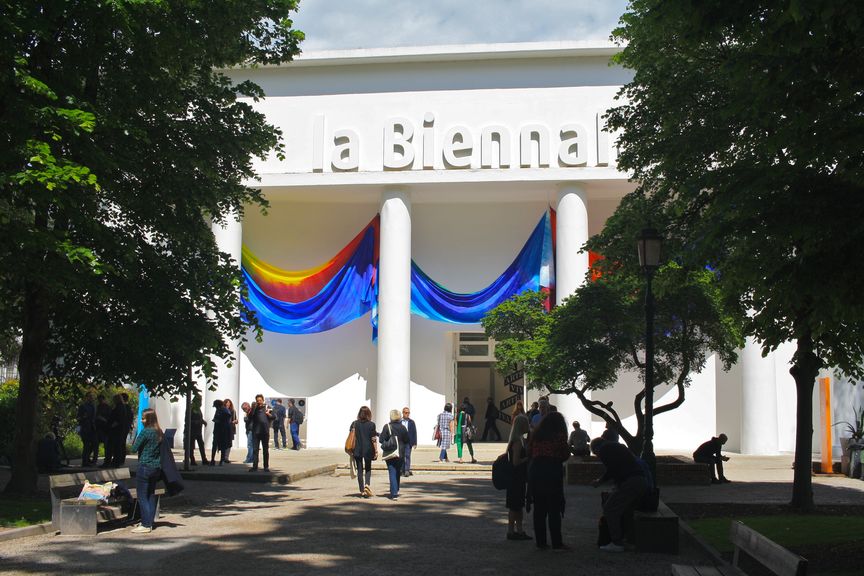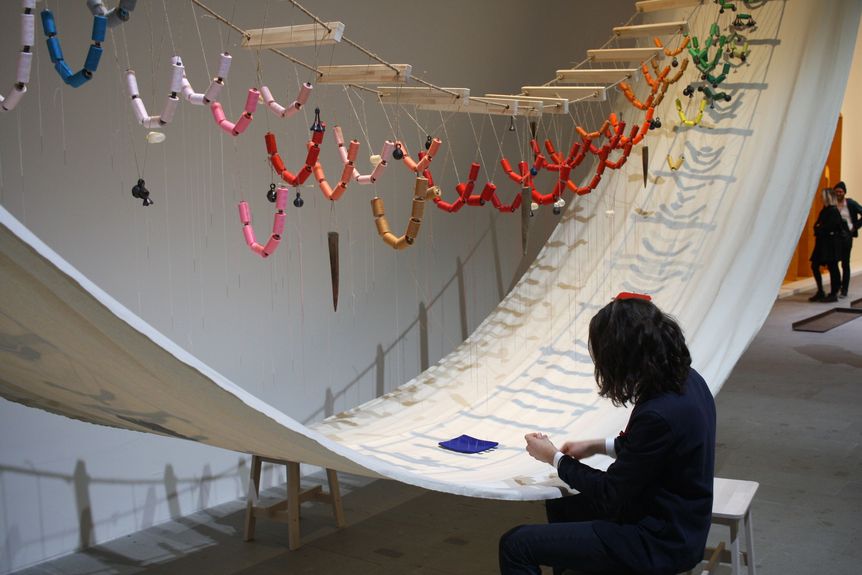
R
E
V N
E
X
T
There are many colors, fabrics and textiles, books and beds, and playfully interactive components among the works by 120 artists at the 2017 Venice Biennale, which opened this week. Just as the title, “Viva Arte Viva,” suggests, the 57th Venice Biennale, curated by Christine Macel, has a celebratory spirit, foregrounding art over discourse. If Okwui Enwezor’s edition of the Biennale two years ago was like an anthology of postcolonial discourse, then Macel’s is like a re-issued collection of world poetry. The 2017 Venice Biennale opens at a time, Macel acknowledges, when the world is “full of conflicts and shocks,” but the French curator presents art as the “last bastion” and, in an explicitly humanist worldview, as “the ultimate ground for reflection, individual expression, freedom, and for fundamental questions.” Macel proposes that “at a time of global disorder, art embraces life, even if doubt ensues inevitably.” You come away from this Biennale not burdened (but also not unburdened) by history, yet uplifted by art’s own discoveries of worlds slightly apart from the ones that bring us so much trouble in our regular lives.
In its primary objective to put art—and artists—first, “Viva Arte Viva” excels, with Macel bringing a commodious, museum-like presentation to the Central Pavilion at the Giardini and the Arsenale. On first impression, the art itself looks good, and it especially looks good when presented all together. The exterior of the Central Pavilion is draped in a colorful fabric—a “drape painting”—titled Yves Klein Blue (2016), by Sam Gillian, an African-American Color Field painter who exhibited in the United States pavilion in 1972, and whom history (and art history) had largely forgotten. Right inside the door is a tribute to the late Mladen Stilinović (1947–2016), a member of Zagreb’s 1970s experimental art scene, rendered in photographs of the artist lying in bed for a performance series of his cheekily called Artist at Work (1978). Behind the partition in the Sala Chini are the contents of Dawn Kasper’s “nomadic studio,” where a band was jamming. There are also many references to books in the coming rooms: in the lovely paintings of Liu Ye—whose obsession with Mondrian shines in his compositions—which Macel paired with the diaristic scrolls written by Abdullah al-Saadi that the artist keeps in self-customized metal tins, and the ink-soaked volumes by Geng Jianyi, which inhabit the same room as book-embedded wall sculptures by Jonathan Latham. Another ebullient spirit, the late Hassan Sharif (1951–2016) has a room of his own where his eclectic assemblages of plastic and metal objects, tied together with jute or copper wire, sit on metal shelves as if they were in a supermarket. There’s much to be said for artists finding new ways to fashion things from all the mediocre and unlovely things already in the world.
Over at the Arsenale, there’s plenty more color and fabric, as well as artists that have been overlooked by history. This includes the opening pairing of an anthropological video work depicting members of indigenous tribes by the Chilean artist Juan Downey (1940–1993), with Rasheed Araeen’s “Zero to Infinity” series (1968–2007) of colorful stackable cubes. Lee Mingwei has reprised his Mending Project (2009/14), where damaged clothing, donated by members of the public, is being repaired with a rainbow of colorful fabrics. Lee’s work finds its karmic ancestor in David Medalla’s A Stitch in Time, which dates from 1968, in which the artist invites people to donate swatches of fabric (perhaps from their own clothes) by stitching a bit onto a canvas using colorful thread. At the Arsenale, the exhibition is much more obviously demarcated into what Macel calls “trans-pavilions,” thematic clusters such as the “Dionysian Pavilion,” the “Pavilion of the Earth” and the “Pavilion of Colors.” Macel revisits the utopianism and environmentalism of the post-1968 moment through lesser known characters, such as the Japanese collective, The Play, whose collective actions included building a floating house and navigating down the Uji, Yodo and Dojima Rivers between Kyoto and Osaka, first in 1969 and then again in 2011. She revisits Buenos Aires-born artist Nicolas Garcia Uriburu (1937–2016), who in 1968, amid general controversy over the Biennale that year, poured 30 kg of fluorescein into the water of the Grand Canal, turning it green for eight hours. Thu Van Tran’s visually stunning installation of sculptures and photograms looks at the rubber industry in south Vietnam and all the environmental and political disruption it has caused, while Koki Tanaka’s walking project addresses nuclear power, an industry that now haunts Japan. Sopheap Pich’s abstract drawings and a sculpture share the Arsenale corridor with Yee Sookyung’s massive tower of gold-lacquer repaired ceramics, Nine Dragons in Wonderland (2017)—both works are about ideas of “repair.” A plinth featuring Francis Upritchard’s sculptures makes her miniature humans look particularly engaging and poignant. Huguette Caland’s paintings and painted dresses are featured in a section about feminism and the body, while Hale Tenger’s video installation Ballons on the Sea (2011) features balloons floating on the water being shot at, but which nonetheless return, in a metaphorical act of renewal and resistance.
There’s a lot more to chronicle in this 57th Venice Biennale, but there’s a throwback vibe to the idealism of the 1970s, and the internationalism and solidarity of that time. It’s also notable that Macel seems to be navigating a very narrow channel between the art world’s professionalized intellectualization and its commercial industry-ification. This approach is refreshing as there has been a harsh polarization in the art world between art yoked into service of sociopolitical discourse and art that is so often (but sometimes unfairly) exploited by culturally elitist commercial forces. I’m sure both polarized sides will protest Macel’s third way: with one side decrying the Biennale’s lack of overt polemics, while the other side will complain about the absence of Top 100 auction and art-fair bestsellers. But let’s not forget that this Biennale is opening less than a week after a French election when neither the oligarchic conservatives nor the exhausted, faux-progressive “socialists” of François Hollande’s party could mount viable candidates. I was happy to see a lot of art by artists I was unfamiliar with, and to see it so well cared for and brought together in good company. More about the Venice Biennale tomorrow—specifically about the National Pavilions.
HG Masters is editor-at-large of ArtAsiaPacific.
To read more of ArtAsiaPacific’s articles, visit our Digital Library.




